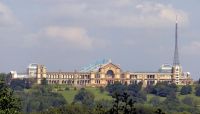Lights. Camera. Action.
By Andrew Selwood
19 January 2016

Over the course of its history Alexandra Palace has been associated with a host of events - from music concerts and ice skating to darts competitions and snooker tournaments.
Its famous mast which now houses radio and satellite transmitters was once used to transmit television across the country and was used to disrupt navigation signals in the Battle of Britain.
Max Fordham are working on the refurbishment of the listed building. Part of our work is providing a lighting scheme for the mast, the tower and the adjoining south colonnade. We initially approached the design of the lighting scheme in a traditional way by modelling the mast in Dialux (a computer software for professional light planning).
It was quite a daunting task given the mast's complex shape and lack of available information about its dimensions. After seeing the Philips Architainment luminaires in action during a Continuing Professional Development (CPD) event, I was confident that a demonstration of the fittings to our client would give quicker and better results. If the lighting worked, it could allow us to adjust the output and position of the luminaires in real time, onsite, with live feedback from the client.
Our thought was to 'pick out' the structure with lighting from each corner of the mast, with a central fitting acting as a beam up to its tip. The client advised that the aim was to have one elevation lit for viewing by key stakeholders during the demonstration. The ante was upped when we were tasked with getting the scheme together to coincide with a tour of VIPs and funders. No pressure then.
To my delight the client team were ecstatic with the result. By connecting the mast to a controller at the base we were able to sync the mast lights with the fittings that we were also trialling on the tower facade. The result was a scheme that lit the majority of the mast, and also demonstrated a synchronised colour-shift scheme to the stakeholders and their VIPs. This highlighted a number of design issues, in particular the problem of lighting beyond a solid platform located in the upper part of the mast. Feedback from the client also meant that we are now looking to light vertical sections of the tower in addition to the central piece - something we had hoped for all along.
Had we presented a 3D model of our proposals I doubt that we would have had the same level of engagement from the client. They were able to see our design intent first-hand and make contributions which allowed us to alter the look and feel of the installation.
The next phase is to take the lessons learnt from the demonstration to develop the design. I am investigating the potential of using cost effective controls that would allow us to synchronise the mast, tower and the colonnades. This would also allow us to generate colour chase, scrolls and fade effects that can be linked to set scenes or via external inputs. And excitingly, the lighting can then synchronise with visiting exhibitions to truly bring the building to life.
Our next demonstration will be in the summer though. December was pretty cold!











.jpg)
Comments
Add a comment